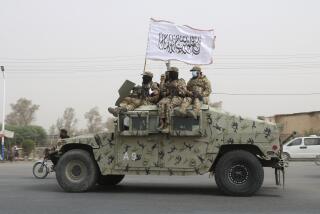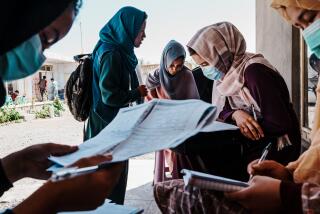23 Months After Soviet Withdrawal, War in Afghanistan Refuses to End : Asia: The Kabul government proves to be much stronger than expected, making deals with some rebel leaders while continuing to fight others.
PESHAWAR, Pakistan — In the distant, snowy Hindu Kush of Afghanistan, the mountain stillness is broken by the rockets, bombs and bullets of a leftover war against a faded ideology.
“We will fight until communism is gone from our country,” said Gulzaman Tahidyar, a 21-year-old guerrilla. “We will bring Islam to Afghanistan.”
“We will live in the desert, we will live in the mountains, but we will never accept communism,” said Tahidyar, the anti-communist slogans of the early 1980s tumbling out.
The young warrior prepared to return to the mountains, as he has for eight years, but time has passed him by. The enemy he fought so hard for so long isn’t really there anymore.
Soviet troop convoys that rumbled through his homeland for nearly a decade have been gone for two years. In Kabul, the government has abandoned the Marxist ideology it once tried to impose on a rural, Muslim people and seeks to cloak itself in Islam.
Like most moujahedeen , or Islamic holy warriors, Tahidyar talks more and more of fighting “with the last drop of our blood,” less and less of victory or what it might mean. The war, now in its 12th year, is no longer a clear ideological struggle.
It has cost more than 1.5 million lives and created nearly four times as many refugees.
About half of the dead and displaced are children. The high rate of infant mortality is rivaled only by Cambodia and the Sudan. Tuberculosis and malaria are the biggest killers in refugee camps and within Afghanistan itself.
When the last of the 115,000 Soviet army troops left Afghanistan on Feb. 15, 1989, the Muslim guerrillas and their Western backers confidently measured the Kabul government’s survival in weeks and months.
Few thought the moujahedeen would even have to fight. President Najibullah’s government, they were convinced, would collapse from within and the guerrillas would march triumphantly into Kabul.
They were wrong.
Twenty-three months later, the optimism is gone. Disappointment and despair fill the dried-mud refugee camps around Peshawar, the western border city that has been the staging area for men once romanticized as valiant freedom fighters who challenged the mighty Soviet army.
In Afghanistan, little has changed since the Soviet withdrawal. Soldiers loyal to Najibullah hold the cities and the moujahedeen control much of the countryside.
With the Soviets gone, the world has grown indifferent to a country that seems, except for an array of modern weapons, still to live in the 14th Century.
The United States and Soviet Union are trying to work out a face-saving exit from the bloodiest conflict of the 1980s. It is expected to include a cease fire, transition government and internationally supervised elections.
On Dec. 11, they announced an agreement to stop supplying weapons to the Afghan belligerents, but did not set a cutoff date.
Both have recalcitrant clients, and no deal they make will guarantee peace. History has shown that the fiercely independent Afghans do not accept political parties, a strong central government or the tutelage of outsiders.
“No one, not even the superpowers, can impose their will on the people of Afghanistan; this we can prove,” said Gulbuddin Hekmatyar, considered the most ruthless, ambitious and anti-West of the seven guerrilla leaders.
Hekmatyar is said to have a two-year stockpile of arms paid for by Saudi Arabia, Iraq and Libya, and can try to spoil any settlement he doesn’t like.
The most pressing problem for all parties is to find someone who can replace Najibullah and pull the warring factions together.
Najibullah, former chief of the secret police, has proved a more clever, formidable politician than most people thought, including his Soviet sponsors. The Americans acknowledge the moujahedeen have no one to match him.
Washington has dropped its demand that Najibullah resign before elections take place, but insists he transfer authority over the military, secret police and official media to an interim coalition of all parties.
Najibullah has offered to give up control of security forces and some other powers if the major guerrilla groups enter negotiations. They have rejected the proposal.
Moscow still believes Najibullah is the only person who can control the more hard-line elements of his Hezb-e-Watan, or Party of the Homeland, which was the People’s Democratic Party of Afghanistan until early this year.
Najibullah has traded in loyalties, risen with his rivals’ failures and used money and power to buy time for himself and his government. He has brought peace of sorts to parts of the country by making live-and-let-live deals with local moujahedeen commanders.
Unlike the guerrillas, Najibullah at least pays lip service to the people’s yearning for peace, appealing for an end to the war and for the return of nearly 6 million refugees from neighboring Pakistan and Iran.
He has admitted the mistakes of the April, 1978, revolution that brought communists to power and tried to convince the world that his government has changed, but many Afghans still blame him for much of the bloodshed.
“We will fight Najibullah and communism while we live; if we die, our children will fight,” said Wali Mohammed, 70. “If our children die, our ladies will fight. There are many children who have never seen their country, but they will grow up to fight Najibullah, God willing.”
Most Afghans may not accept Najibullah, but many also reject Hekmatyar and the other six resistance leaders who have made huge fortunes off the war. Personal ambition and murderous infighting doomed a government in exile the leaders touted as the alternative to Najibullah.
With time and American money running out, moujahedeen field commanders have ignored their leaders, set aside personal and ethnic differences and are coordinating attacks in what could be their last chance to win. Most observers say it’s a good idea that may have come two years late.
More to Read
Sign up for Essential California
The most important California stories and recommendations in your inbox every morning.
You may occasionally receive promotional content from the Los Angeles Times.










